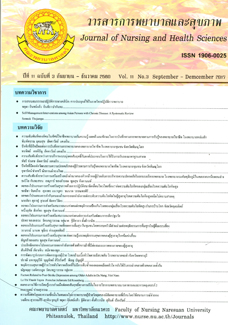Effects of Enhancing Self-Efficacy Program on Prevention Behavior Among Risk Group of Pre-Hypretension In Bankhok District, Uttaradit Province
Main Article Content
Abstract
The purpose of this two groups pre-post test design was to study the effects of enhancing Self-Efficacy Program on prevention behavior in nutrition, exercise, and stress management among risk group of prehypertension in Bankhok District, Uttaradit Province. The subject weas 40 risk groups of pre-hypertension, aged 35–59 years at Bankhok Hospital service area. Purposive sampling technique by specific criteria was used for both the experimental and control groups (20 each). The research tool was comprised of two parts 1) the experimental tool was enhanced Self-Efficacy Program on prevention behavior Program 2) prevention behavior questionnaire with reliability was 0.86 3) behavior record’s note 4) Sphygmomanometer 5) Pedometer. The statistical device used for data analysis was frequency, mean, standard deviation and ttest. The results showed that: 1. Behaviors of risk group of pre-hypertension in the experimental group after intervention 12 weeks had significantly higher mean score than before intervention (P< .01) in all behavior (nutrition, exercise and stress management). 2. Behaviors of risk group of pre-hypertension in experimental group after intervention 12 weeks had significantly higher mean score than a control group (P< .01) in all behavior (nutrition, exercise and stress management). 3. The mean score of systolic blood pressure level and diastolic blood pressure level in the experimental group before intervention had significantly higher mean score than after intervention in 12 weeks (P<.01). 4. The mean score of systolic blood pressure level and diastolic blood pressure level in the experimental group after intervention had significantly lower mean score than control group in 12 weeks (P<.01).
Article Details
References
กรุงเทพฯ: สำนักพิมพ์จุฬาลงกรณ์มหาวิทยาลัย
นุชนารถ น้ำจันทร์ ประทุมา ฤทธิ์โพธิ์ และชมนาด วรรณ
พรศิริ. (2557). ผลของโปรแกรมการสร้างเสริม
ความสามารถแห่งตนต่อพฤติกรรมการควบ
คุมน้ำหนักและค่าดัชนีมวลกายของหญิงที่มี
น้ำหนักเกิน. วารสารการพยาบาลและสุขภาพ,
8(2), 99-109.
ปาริชาติ กาญจนพังคะ จรรจา สันตยากร ชมนาด วรรณ
พรศิริ และทวีศักดิ์ ศิริพรไพบูลย์. (2552). ผลของ
โปรแกรมส่งเสริมการรับรู้สมรรถนะของตนเอง
ต่อพฤติกรรมสุขภาพและระดับความดันโลหิต
ของผู้ป่วยโรคความดันโลหิตสูง. วารสารมหา
วิทยาลัยนเรศวร, 17 (1), 63-73.
สถาบันวิจัยและ ประเมินเทคโนโลยีทางการแพทย์
(2555). คู่มือการให้ความรู้เพื่อจัดการภาวะ
ความดันโลหิตสูงด้วยตนเอง. สืบค้นเมื่อ 22
กุมภาพันธ์ 2556, จาก http://www.thaihyper
tension.org
สมโภชน์ เอี่ยมสุภาษิต. (2550). ทฤษฏีและเทคนิคการ
ปรับเปลี่ยนพฤติกรรม. (พิมพ์ครั้งที่ 6).
กรุงเทพฯ : จุฬาลงกรณ์มหาวิทยาลัย.
สมาคมความดันโลหิตสูงแห่งประเทศไทย. (2558).
โรคความดันโลหิตสูง. สืบค้นเมื่อ 22 กุมภาพันธ์
2556, จาก http://www.thaihypertension.org.
สำนักงานสาธารณสุขอำเภอบ้านโคก. สรุปผล
การดำเนินงานตามตัวชี้วัดผู้ตรวจราชการ
คณะกรรมการประสานงานสาธารณสุขอำเภอ
บ้านโคก.(2557). อุตรดิตถ์:สำนักงานสาธารณสุข
อำเภอบ้านโคก
สำนักโรคไม่ติดต่อ กรมควบคุมโรค. (17 พฤษภาคม
2557). ประเด็นสารวันความดันโลหิตสูงโลก
ปี พ.ศ. 2557. สืบค้นเมื่อ30 ตุลาคม 2557, จาก
http://dpc2.ddc.moph.go.th/infopublic/data/1/
0010-1.html.
สำนักนโยบายและยุทธศาสตร์ สำนักปลัดกระทรวง
สาธารณสุข. (2556). จำนวนและอัตราผู้ป่วยใน
ด้วยโรคความดันโลหิตสูง ปี พ.ศ. 2550-2556
จำแนกรายจังหวัด เขตบริการสาธารณสุข. สืบ
ค้นเมื่อ 30 ตุลาคม 2557, จากhttp://bps.ops.
moph.go.th/Healthinformation/statistic55/
statistic55.html
อมร กิมหงวน.(2552). โครงการศึกษาโปรแกรมการ
เดินโดยใช้เครื่องนับก้าวและโปรแกรมการ
เดินตามคำแนะนำของอเมริกัน คอลเลจออฟ
สปอร์ตเมดิซีนที่มีผลต่อสมรรถภาพทางกาย
ที่สัมพันธ์กับสุขภาพ ศูนย์อนามัยที่ 10 จังหวัด
เชียงใหม่. สืบค้นจากhttp://kcenter. anamai.
moph.go.th/info.php?info_id=851& group_
photo=&SUBORG_ID=0 Bandula, A. (1997).
Self-efficacy: Toward a unifying of behavior
change. Phychological Review, 84(2), 191-215.
World health Organization.(2011). World Health
Organization Regional Office for South-East
Asia Retrieved September10, 2014, from:
http://www.searo.who.int/entity/noncommu
nicable_diseases/media/non_communicable_
diseases_hypertension_fs.pdf


